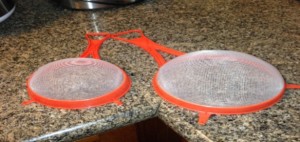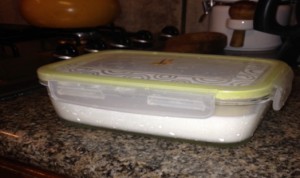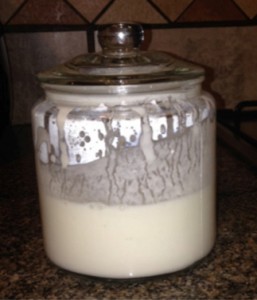By far the most common question that I get from people after they’ve read my article “Kefir: A Wonder Beverage from the Ancient World“ is “How do I get started making my own kefir?” Here’s my step-by-step guide on how to ferment your own kefir in your own home.
As an avid home “brewer” of milk kefir, I often have extra grains to share with friends and acquaintances. Along with the grains, I provide instructions on how to care for the grains and how to ferment the kefir. Although it is easy to make, there a few things to watch out for to ensure that you make the healthiest and most delicious kefir.
There is no one “right” way to care for your grains. How long you will ferment them will depend on your climate and the season as well as your personal tastes and how strong you want it. Don’t be scared to experiment.
Kefir tastes like a slightly sour, slightly effervescent, plain yoghurt. The texture will also be similar to yoghurt, although it is typically somewhat runnier.
These instructions can be used as guidelines to get started.
1.) Locate & Obtain Grains. The kefir grains are a living polysaccharide matrix of healthy bacteria and yeasts. Because they require a steady diet of fresh milk and regular straining to survive, they are not readily available from a store. However, with a little looking around you should be able to find them, either from within your community or from specialized vendors. They may be located here:
- Local community list serves. These are excellent places to find them because if you can obtain the grains locally, they will be fresh and won’t have had to survive dehydration and shipment. I located my starter grains on a Facebook group for Singapore expats after posting on the group that I was looking for them. There are often community groups that discuss healthy eating and natural health that might having members who have grains to share.
- Notice Boards. You can look on notice boards in local health food stores or markets. People may have posted that they have grains available. Alternatively, you could put up a sign on the board indicating that you are interested in obtaining grains. As mentioned above, obtaining grains locally is the easiest way to obtain healthy and fresh grains.
- Local Classifieds. Online classified like Craigslist may have listings for people within the area who are willing to sell or share kefir grains that can be obtained locally, thus assuring that the grains will be fresh.
- Amazon and eBay. These online marketplaces have vendors who sell kefir grains for a nominal fee. Grains that will be mailed or shipped may be fresh or may have been dried out by the vendor. You should try to obtain grains that are shipped fresh if possible, packaged in liquid milk or whey. If you purchase dried out kefir grains, when you receive the grains, you must revive them before they can produce consistent and tasty kefir. If they are too old or haven’t been properly stored, reviving the grains could be a challenge. The vendor should supply instructions on how best to do this. Read the reviews for the vendors before purchasing.
- There are a few websites such as Cultures for Health, The Kefir Lady, and Organic Cultures that sell milk (and water) kefir grains and will ship them internationally. I cannot vouch for them as sellers nor can I speak to the quality of their grains as I have no personal experience with them. There may be others.
2.) Obtain Kitchen Tools.
- NOTE: Kefir is acidic and because of this, it is important that you do not allow the grains or your kefir to come in contact with metal. The metal can damage the grains and erode into the kefir itself – meaning you could drink metal bits. No metal utensils or storage containers!
- NOTE: Because of the acidity, do not ferment or store kefir in plastic. Otherwise the plastic might erode and get into your kefir and thus you would be drinking plastic.
- Plastic strainer – you will strain the grains out of the fermented kefir. For this, you will need a plastic strainer (with plastic mesh)
- Glass container for fermenting. You can start with a container that
 can hold about two cups of liquid. (Make sure the lid is not metal).
can hold about two cups of liquid. (Make sure the lid is not metal). - Glass container for storing kefir.
- Milk.
- Type of milk. Kefir grains require mammal milk (cow, goat or even human (!)) to live and to make the kefir. Milk kefir grains will die if you use soy milk or almond milk.
- Full or low fat? From my experimentation, I have discovered that whole fat milk makes the best kefir, although it will still work with low-fat milk. Skim milk does not make good kefir and the grains will become unhealthy.
- Fresh, UHT or powdered? Fresh milk makes the best tasting, most healthful kefir. UHT milk may work okay in a temporary pinch, but won’t work over the long-term as the grains will become unhealthy. Powdered milk is not suitable for making kefir.
3.) Ferment the Kefir.
- Combine milk and kefir grains. Place the grains and the fresh milk into a glass storage container. The ratio of grains to milk is approximately 2 TBS of grains to 1 ½ cups of milk. The amount of grains that you have and how strong you like it will dictate how much milk to use.

- As you experiment, you might decide to alter the ratio by adding more or less milk to suit your taste.
- Your grains will reproduce and grow over time. As they do, you will need to either increase the milk or remove some of the grains (which you can eat, blend into smoothies, share with friends, or feed to your pets)
- You can ferment it with the lid closed (as pictured) or lightly covered with cheese cloth or a paper towel (to keep out pesky critters or dust). Fermenting with a closed lid will create kefir that is slightly more effervescent and this is how I prefer it.
- Temperature. Keep the fermenting kefir at room temperature.
- Putting it into the refrigerator will slow fermentation almost to a stop so it is not effective for making kefir.
- Because there are so many healthy microbes in the kefir grain, the milk does not spoil during fermentation, even though it sits out at room temperature.
- Length of Fermentation – How long it takes to complete will depend on your climate. The hotter it is, the quicker it will be done.
- The kefir takes about 24 hours to finish in a Mediterranean climate (65 – 75 degrees Fahrenheit).
- In Singapore, (85 plus degrees Fahrenheit) it is finished in about twelve hours.
- As the seasons change, the kefir will take more or less time to complete fermentation, and you might also notice the consistency changing temporarily as the grains adjust to the new climate.
4.) Finish Fermentation.
- How do I know it is done?
- When it is done is depends on your tastes!
- The longer it ferments, the more sour it will become, but the amount of probiotics in the kefir will also increase.
- For my taste, I think it is done when it becomes thick (like a slightly thick yoghurt), but I stop fermentation before the curds and whey have separated (see below).
- If you leave it longer, the curds and whey will start to separate and there will be a line between them in the container. The whey (the bottom layer) looks like a slightly whitish liquid and the curds (more solid part)(top layer) may look thick and lumpy. It’s ok to consume like this, but it is not to everyone’s taste. If you have kefir like this, you can mix it with juice and frozen fruit and make a smoothie to cover the strong flavor.
- Strain the grains out of the kefir with the plastic strainer.
- Put the finished kefir in a storage container and store in the refrigerator.

- Grains that you have strained out must be put back in fresh milk within 20 minutes or so, or they will starve and die. Put the grains in a glass container and start a new batch by adding milk. Ferment at room temperature.
- There is no need to rinse the grains after fermentation. The beneficial microbes in the grains will keep them from “going bad,” even if there is a bit of residual kefir on them from prior fermentation. If you must wash the grains, rinse them with milk – not water. DO NOT use soap or other cleaners, which will kill the grains. DO NOT use tap water as the chlorine it contains will kill the grains.
- You can wash the glass container between fermentation cycles. However, chlorine in the water and harsh detergents can damage the grains. Rinse the container well after wishing and either give the cleaned container a final rinse with filtered water (to wash off the chlorine from the tap water) or let it dry thoroughly to allow the chlorine to evaporate. Tap water will kill the grains.
- Note on First Few Batches. Kefir grains can be temperamental about their environment. When you first obtain your grains, the first few batches of kefir that you ferment may be runny and taste sour. As they get used to the new environment and the type of milk you are using to make the kefir, the kefir will start to stabilize and taste better. It is generally ok to consume these first few batches unless they smell or taste foul. If a batch smells off, toss it out and try again a few more times.
5.) What if I will be Travelling or Want to Temporarily Stop Fermenting? How to take a break from Kefir Making.
- Sometimes you may want to temporarily stop making kefir perhaps because you will be travelling or because you have accumulated too much in the refrigerator that you need to drink before making more.
- The kefir grains require a constant source of milk to survive, but the microbes’ metabolism (and thus the fermentation) can be slowed down dramatically by putting them in the refrigerator.
- To do this:
- Strain out the grains from the kefir that they have been fermenting in.
- Place grains in a fresh batch of milk.
- Depending on how long you are planning on keeping them refrigerated, you may need to put them in more milk than you might typically use for fermenting. Remember – the milk is the food that keeps them alive and the longer you’ll be away, the more you should use.
- When you are ready to start fermenting again, take them out of the refrigerator.
- If they have been refrigerated for three days or less, there is no need to change the milk.
- If they have been in the fridge for longer, then strain them out from the milk they’ve been in and put them in fresh milk.
- Start fermenting, as usual.
- If the grains have been refrigerated for a while, they may be slightly shocked once you take them out and this may affect the taste and/or thickness of the first few batches of kefir.
- Grains can be successfully refrigerated and revived for periods up to three to four weeks.
- If you will be away from them for more than three to four weeks, you want to store some extras for safe keeping for up to six months, or you want to mail them to someone, grains must be dehydrated.
- Rinse the grains thoroughly with chlorine-free water, preferably bottled water or well-water to remove kefir. Lay out to drip off on a clean towel or paper towel.
- Put the grains on a piece of unbleached parchment paper and cover them loosely with a paper towel (to keep dust off). They can dry at room temperature until they become hard and yellowish. This will take about 3-5 days.
- Store the dehydrated grains in the freezer.
- For excellent instructions on how to rehydrate the grains, click here.
These instructions are from personal experience mostly. Please add your own tips below in the comments.






I have just started my first Kefir with powder, not grains. I am new to this and have read much about Kefir grains which seem to me to be much better than powder. I intend to let it ferment for 48 hours but am not sure how to make a second batch. To do this with Kefir grains sounds quite easy but can I get advice for my next step(s) of how to continue with my powder.
Hello! I love kefir. A mate introduced it to us after I was diagnosed with ovarian cancer. I love the stuff, and I drink at least one cup a day, in the morning. We make the fresh kefir, strain it and leave it on the bench for 12 – 24 h for second ferment, then put that in the fridge. I love everything about kefir. I am under the care of an oncologist, and a naturopath. I am still here 7 months post surgery and fingers crossed have dodged a bullet.
Very happy to hear you’re still here. Thank you for sharing … wish you continued health & wellness 💛
Thank you J. Porteus for the excellent instructions. I used to make milk kefir around 35 years ago while living in another country.
This past week a visitor came to stay with us and he brought a plastic cup with kefir and kept making more while here.He left me grains and I started making my own kefir again. He used a metal strainer because I did not have a plastic one, but I will buy one tomorrow, after learning from you, that we should not use metal. Many thanks.
Hello. I just received my dry grains in the mail. I’ve discovered a bit late that the only milk I have available is UHT and Evaporated. The other thing available that is just normal ‘pasteurized’ is CREAM. Q. which one of these should I activate them in and make kefir in.
Frank
How do you use the milk the grains have been feeding on if you’re not making more kefir right away?
Hi everyone.
Do you find that your kefir also makes a sort of slimey like consistency around it? I give it fresh milk every morning. And had the same thing with my previous one, before I accidentally ‘killed’ it.
Thanks
Zeldine
Hi
I was wondering has the “resting” milk some probiotic properties as well please?
I had those grains some years ago but got very specific one page instructions with them. My daughter brought some & forgot them going home. She has them in jam jar with metal lid. She drained the water off them to take back but forgot them & lying in fridge in jar without any liquid from Sunday to Thursday. I’ve put half cup of full fat into jar to cover them & wonder are they dead now. How would I know?
You will be able to tell if they have died if they stop making kefir meaning when you leave them in milk, it never thickens up. But give them a couple of rounds of fermenting and straining before entirely giving up on them. I suspect they may come back to life.
Good luck!
I totally agree with Jen. I believe kefir is tough and long as you don’t have off colors and you give it a chance it probably will be Ok but it might take a few batches to fully recover. I use 1% milk to make mine, mine were bought from a seller who used whole milk. It has more lactose in the milk than whole milk. Good thing they were in the fridge covered since they had nothing much to eat.
Please advise: I have had great success initially with milk kefir grains. the temp in the roo has reduced due to winter starting here in the UK. Now my grains will produce thick kefir but also have 20 percent watery consistency that i tip away. The fizz that I was getting from the summer months has gone. My grains have become quite large and dispose of approximately half a table spoon from the grains and maintain possibly two table spoons of grains to approx 3/4 a pint of milk.
Are some of the grains perhaps inactive. I was using them to help with Crohns disease and they were fantastic initialy and have helped me off of steroids. I have now had a flare up and the Kefir does not seems to help.
Hi John,
Sorry I don’t know the answer to this. The kefir consistency does change with weather and temperature.
You may want to experiment with the timing of how long you ferment the kefir for. You can stop the fermentation as soon as it seems thick, and that should prevent the watery liquid (whey) from forming on top. If you do have the watery whey, though, don’t tip it off. Mix it in with the thicker kefir. The whey is full of probiotics, too. Maybe this is why you had a flare-up.
You might also try “resting” your kefir grains in the fridge for a week or so. Put them in with milk and then don’t use them to make kefir during that period. (Since you have extra grains you can rest some while still using the others). Then “wake” them up by straining out the grains, putting in fresh milk and fermenting. Sometimes after a rest, it make take a few batches before it gets really good again.
If none of this works, you can try to get a new set of grains and start over.
But again, seasonal variations are normal.
Jen
I froze my grains according to Dom’s instructions on his website. I have frozen them twice and both times they bounced right back. Dom is the fellow from Australia who gets credit for his extensive kefir knowledge from everyone else on the web it seems!
How to freeze dairy kefir grains is here-
http://users.chariot.net.au/~dna/Makekefir.html#Storing_kefir-grains
Hi I am looking for milk kefir grains. Do you have any spare to share? I’m trying to heal my gut. Thanks.
This is where I got mine and they are growing nice.
http://www.culturedfoodlife.com/
where does one get the dried grains of Kefir from?? Are they sold in pharmacies??
Great guide! Just wanted to say I’ve been using powdered milk with my kefir for months with great success! Also after I gave my kefir a rest in the refrigerator the first couple of batches have gone sour, not kefir sour but off milk sour. The grains still look healthy and ferment but maybe have I used too much milk while they’re sleepy and they can’t keep up?
Hi Nayt,
Thanks for your comment.
Interested to hear that you’ve had success with powdered milk. Hadn’t tried that before. Did you use full fat or skim milk powder?
The grains do stay a bit sleepy after a rest in the refrigerator. Sometimes it can take up to three batches to return to normal. Milk kefir grains are quite resilient, though, and should return to normal. However, if they do not return to normal after some time, I would become concerned, and consider tossing them out and starting over.
When resting in the fridge, be sure that they are kept in sufficient fresh milk as they still require food, although the rate of fermentation is greatly slowed down. You don’t want to starve them while they’re resting.
I’ve been using full fat milk powder at the ratio recommended by the pack and sometimes with a little extra as a treat for my babies.
My batch has just started to wake and get back to normal after my third batch out of the fridge. It’s amazing how attached I’ve become to these globules. I was feeling a bit heart broken haha.
Thanks for your advice!
When you give the ratio of kefir grains to milk do you mean dried grains?
Thanks
Sorry for the late reply, Lisa! When I give the ratio of kefir grains to milk I am not referring to dried grains, I am referring to active grains. Let me know if this does not make sense.
Excellent advice. Thanks Jenney.